2021
Uncovering and Understanding Complex Electrical Claims
There is no exact definition for complex claims because they come in different forms. They usually involve multiple stakeholders, but not always the same ones. The only constant with complex claims is unpredictability, which makes them challenging. Complex electrical claims are no different.
There are inherent technical complications with electrical failures. Sometimes, the signs of failure can manifest at a distance from the root cause. Other times, the removal of power leads to physical changes in the scene. It makes it difficult or even impossible to distinguish electrical causes from the effect of a fire. These factors contribute to the complexity of electrical claims.
Electrical claims can also be subject to legal, logistical, safety, and other complications that are not necessarily present in different types of losses.
Case study 1: Electrical injury
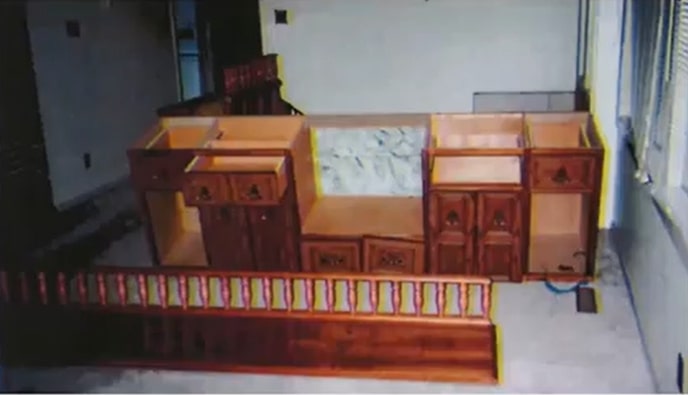
Figure 1: The cabinet that hid the unconnected end of the cord.
A toddler got injured in a rented house she was living in with her family. A double plugged extension cord was connected underneath a built-in cabinet. The unconnected end was hidden under the cabinet. During a game of hide-and-seek, the child hid in the area. She grabbed the energized end of the cord and got injured as a result. The toddler suffered severe injuries to her mouth, face, and one finger. These injuries involved permanent scarring and damage to her face and mouth, limiting movement and facial expressions.
Through a litigation guardian, the toddler sued the landlord, property manager, former owners of the house, and other parties.

Figure 2: A model of the cabinet showing the electrical installation.
Initial observations
We were retained later than the incident. As such, we only received a few photos of the scene. We, therefore, generated the model in figure 2 based on information we received. It was determined, during the trial, that tenants likely modified the cabinet after the landlords purchased the house.
There was an electrical outlet box mounted underneath the cabinet with power supplied from under the floor, near the center of the cabinet. A double plugged cord ran from that outlet through the bottom cavity of the unit to the other end. There were also two duplex outlets mounted to the cabinet in a rough install. These were seemingly intended to power stereo equipment.
The way this was built meant there was no legitimate way to power them, except with a double plugged cord. However, if you plug energized cords into one outlet on a duplex receptacle, the other outlet will become energized, allowing you to use that one normally.
Technical issues that were addressed during the investigation:
The client requested that we investigate possible violations of the Canadian Electrical Code, such as:
- Cable supports – Power cables need to be stapled to a joist or a stud at a specific distance to provide support.
- Concealed junction boxes – The junction box was concealed beneath the cabinet and was therefore not visible for maintenance.
- Use of flexible cords – We found improper use of a flexible cord.
We had to determine if these code violations constituted a hazard. The flexible cord issue was the biggest one, but the concealed junction box also meant that a casual observer would not know there was power beneath the cabinets. According to the Canadian Electrical Code, no flexible cord may have exposed energized elements if one end is connected to power.
Preliminary findings and analysis
We had to determine whether the actual injuries matched what would be expected in theory. After some calculations, we found that the injuries matched the theoretical expectations. We also found that the current involved would be high enough to cause significant damage to tissues but not high enough to trip the circuit breaker. This allowed the current to continue flowing despite this incident.
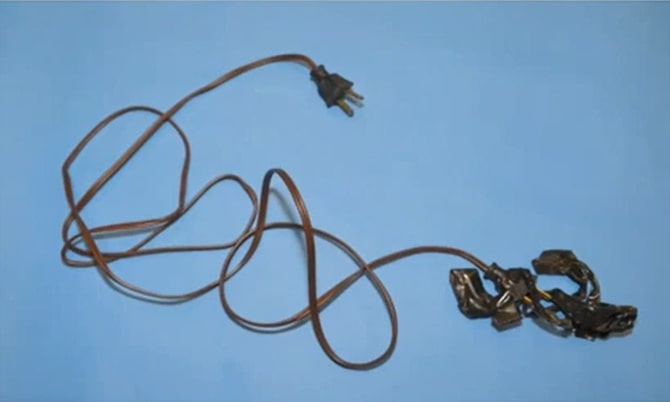
Figure 3: A picture of the cord that was involved.
As shown in figure 3, the cord had two plugins, one with tape on it. However, the cable was made from a lamp cord, and it was homemade. We also found blistering on the non-taped end that could have occurred during the incident.
A few non-technical issues became significant during the trial. The individual who created this hazard could not be identified, and there weren’t sufficient records of every previous tenant of the place. It was also challenging to identify the people who knew of the hazard. The owners had never set foot in the house because they were offshore property owners. The property manager also testified that she was not aware of the hazard.
We needed to determine whose responsibility it was to know of and correct this hazard. The court determined that the property manager’s inspections should have been more rigorous and that she should have looked deeply enough to find something odd.
The court determined that the rough installation would be visible, meaning the property manager should have seen it during her maintenance checks. During the trial, it was found that the main hazard was created after the owner purchased the house. However, it was impossible to determine precisely who created it.
The court found the two property owners and the property manager equally liable. However, they determined that the property manager should have conducted a more thorough review of the property between tenants.
Case study 2: Elementary school HVAC failure
An elementary school’s distributed heating, ventilation, and air conditioning (HVAC) system failed, leading to heat and fire damage. In addition, we discovered an unusual HVAC system in the building. There was an independent heating and cooling unit in each of the 13 classrooms. Heat and fire damage was identified in 12 of the 13 ventilation units.
The school was affected by a widespread power outage the previous weekend, and the smoke and fire damage was discovered the following Monday. Direct fire damage was only found inside the HVAC units in the classrooms. There was no direct structural fire damage, but smoke damage affected every part of the school.
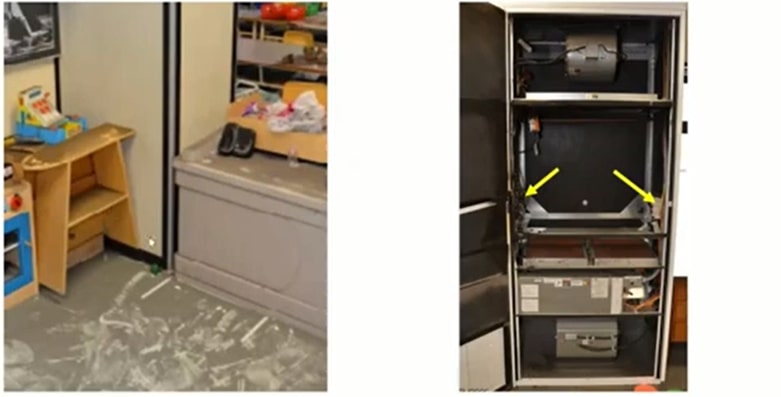
Figure 4: A picture showing that smoke settled on every available surface in the building (left) and another showing direct fire damage to the ventilation units (right).
All student property had to be cleaned or replaced. It included all the school’s fixtures, fittings, and contents, including library books, textbooks, bulletin boards, gym equipment, computers, and AV equipment. As such, this became a large claim with several small stakeholders.
The arrows on the right-hand side image in figure 4 point at the Variable Frequency Drives (VFDs). Each of the ventilation units had two of them.
Preliminary findings and analysis
We discovered that 18 of the 26 VFDs were damaged, and two of the eight undamaged units were in the undamaged classroom.
VFDs control the speed of Alternating Current (AC) electric motors. Due to inherent technical limitations, AC electric motors are usually used for only single-speed purposes. A VFD takes incoming power and changes the wave’s frequency, which subsequently adjusts the speed of the motor. Unfortunately, VFDs are pretty sensitive to poor power quality, especially in three-phase power for large applications (shown in figure 5). If they’re exposed to unmatched power phases, they can react badly.
The VFDs in this school were not defective; they were exposed to input power that they could not handle. Power records indicated that one phase ultimately failed during the outage, while the other two remained on. VFDs can be damaged if one phase drops to about 80% or below relative to the others—power on the phases that remained dipped by up to 75% of nominal voltage. The fuses protecting these VFDs were the slow blow type.
No other equipment had damage, and the power conditions would be expected to lead to failure, heating, and potentially fire in VFDs.

Figure 5: An undamaged unit, one with patterns indicating heat from the inside (left), a partly damaged unit (middle), and one that heated to ignition (right).
This power outage came and went with large fluctuations in power. Therefore, ordinary fast-blow fuses might have protected the VFDs. However, it is standard practice to put slow blow fuses on circuits for motors because they have high startup currents. These startup currents do not typically endanger the supply wiring, even though they exceed the nominal levels for which it is designed. However, they can expose equipment like VFDs to more considerable input variations than they can handle.
Claim complications
· Sheer quantum of the loss – The loss affected a significant part.
· One major party in this claim was the school district, which was self-insured.
· Hundreds of minor parties – Several other parties (students and staff) experienced a slight loss.
· School subrogation opportunities for the loss – The two major parties for the claim (the school district and power utilities) were owned or controlled by the province, which likely reduced the appetite for pursuing subrogation. There were considerations of going after the designer of the HVAC units, but the school and the HVAC system were quite old. Since then, all the maintenance work was done by school district staff, including fuse replacements. In the end, the district had to accept the loss.
Case study 3: Electric vehicle fire in an underground mine
Electric vehicles are attractive to mine operators because they produce no emissions to be ventilated out of the mine. Additionally, they don’t require fuel. This incident notwithstanding, electric vehicles are an excellent solution for that application. A fire involving an electric vehicle, while far from desirable, is less hazardous than one involving a gas or diesel-driven vehicle.
A fire occurred in an electric vehicle inside a mine drift. This vehicle was based on a commercially available chassis and a modified body. The car was parked and not charging at the time of the fire. However, it had experienced some charging issues and caused a ground fault in the weeks leading up to the fire incident. The fire was extinguished and then cooled with briny water.
The fire affected a section of electrical wiring strung on the ceiling of the mine drift, resulting in a brief loss of power for a part of the mine.
Preliminary findings and analysis

Figure 6: A picture of the vehicle after the fire.
Observed damage increased towards the engine compartment, which has the electric motor, one of two battery banks, the charger, and a lot of control circuitry. In addition, there was increased oxidation in front of the vehicle. However, the rear tires were intact, and there was some protection to combustibles in the passenger compartment. Those observations led us to look inside the engine compartment for causation (figure 7).
The battery pack was underneath the fast charger. Therefore, most of the major components had damage indicative of exposure to fire. However, we did not identify any significant electrical damage.
When working with vehicles, we often pay a lot of attention to patterns involving the oxidation of metals. In this case, we had to be cautious with those patterns because the fire suppression was done with briny water, which accelerates and exacerbates the oxidation of the metals. It does not make those patterns misleading, but they don’t always mean what they would on a typical fire.

Figure 7: The engine compartment.
The vehicle had modular battery packs, and we found more significant damage on the left module than on the right. Most of the battery cells were intact; only a few were ruptured. These battery packs usually consist of small cells like those found in laptops and other smaller electronics. During an examination of these cells, we looked for differences in levels of damage and eliminated other potential causes for that damage. 
Figure 8: The damaged battery packs.
Some cell differences can be due to factors external to the battery pack, like fuel load concentrations or exposure to a fire. If those external factors can’t explain the signs, the failure is likely internal to the battery pack. A single cell failure often creates excessive heat, leading to thermal runaway in adjacent cells. We concluded that a thermal runaway occurred in one of the battery cells then spread to others. In addition, we found a localized cavity or damaged battery cells within the battery pack.
Thermal runaway is a feedback loop effect when one cell has a small failure that generates excessive heat. It leads to an increase in the battery chemical rate because batteries run faster when they get hot. That increase in temperature leads to a higher electrical current, which leads to more heat. The effect can start in a single cell and spread to nearby cells.
Safety and logistical challenges
We faced several site-specific challenges during the investigation. There were special precautions and regulatory requirements for an underground location. However, we received in-depth orientation from the mine staff—the other complications involved battery pack handling. We needed to consider that some cells could still be sufficiently intact to carry a charge. So, we used thermal monitoring throughout the investigation to look for hotspots. We also had fire suppression on standby.
Before discarding the battery packs, we considered that some of them could still be energized. As such, each module of the battery pack had to be separately packed in plastic bags, which were placed in barrels along with a non-combustible packing medium. The barrels were sealed for safe removal from the mine.
Fundamental principles of adjusting complex electrical losses
Investigators and adjusters working with complex claims often have specific ways of thinking. However, it is a crucial aspect of all complex losses. When dealing with complex claims, you must be prepared for the unexpected because delays in the repair process are inevitable.
As an adjuster, you need to investigate all potential contributing factors to the cause of loss. For example, it could help determine if other policies contributed to the claim. Moreover, it’s crucial to always think outside the box. Loss scenarios may be similar, and you may have similar pieces of equipment, but the insurance and outside elements can vary significantly.
Essential factors when investigating complex electrical losses
- Determining the root cause of loss and what perils may have contributed to the event – In most complex electrical claims, we engage an electrical engineer to determine the cause of the loss and the scope of repair to the piece(s) of equipment.
- Mitigating damages, especially when there is lost revenue and extra expenses – Many electrical failures have a resulting power outage, leading to lost revenue for the insured or additional costs incurred to restore temporary power to the building.
- Confirming what coverage is available and which policies could respond – Depending on the cause of the loss or the contributing factors, more than one policy could respond to a claim. Except for minor claims, it’s essential to evaluate the coverages available under all the policies enforced.
Types of policies that respond to electrical losses
- Equipment Breakdown (EBI) policy – Covers the sudden and accidental failure of equipment, such as a power surge or short in the system. Claims must meet the definition of “accident to an object” to trigger coverage. An accident, in this context, refers to the sudden and accidental failure of equipment. Generally, if there is no external interference contributing to the failure, it would be considered a pure EBI loss.
- Property policy – Covers all risks of physical loss or damage. These policies exclude damage caused by electrical disturbances to electrical equipment. This common exclusion means a property policy does not respond to internal equipment failure. However, suppose external interference caused damage or loss to electrical equipment. In that case, coverage could be restored under the property policy and possibly under the Equipment Breakdown, at which time you might have a joint loss.
- Combined or a hybrid policy – A combination of property and EBI policies.
Case study 1: Backup generator failure at a hospital
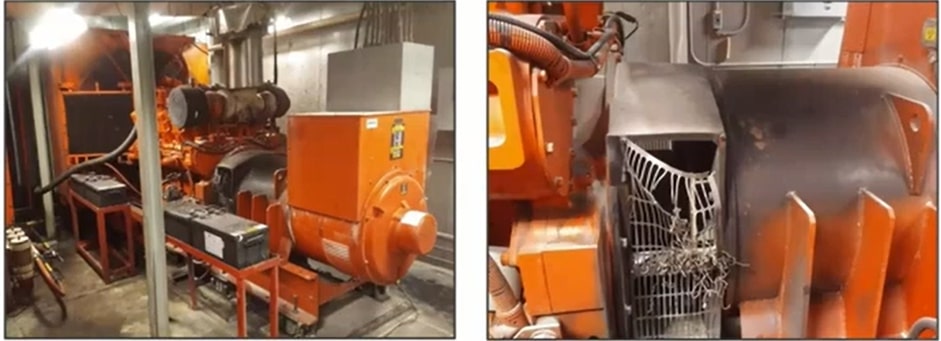
Figure 9: The backup generator (left) and the damaged alternator portion (right).
A unit of the backup generator failed during a routine weekly test by the insured. Damage occurred to the alternator portion of the generator, which includes the mechanical section. These units provide power in a power outage within the hospital.
The insured rented a temporary backup generator while this unit was down. It cost them nearly $20,000 per month. Since this unit had a mechanical portion and an electrical portion, i.e., the engine and alternator, we retained a mechanical and an electrical engineer to determine the cause of loss and scope of repair.
It was determined that the cause was an electrical failure within the alternator side. There was no outside interference, and thus, we had a pure EBI loss.

Figure 10: The generator’s alternator (left) and turbo (right).
Figure 10 shows the electrical and mechanical damages sustained by the generator. The engineers prepared a scope of repair, and we contacted a few contractors to provide repair quotes. We then presented a settlement offer to the insured. The repairs should have been completed within six months of the date of loss, which would have made the maximum exposure for the rental generator $120,000.
Unfortunately, due to unforeseen delays and issues at the hospital, the repair took closer to 20 months, and the extra expense claim increased to approximately $400,000. The lawsuit was settled between $120,000 and $400,000 because the hospital caused the delays, not the insurance company.
Case study 2: Transformer failure at a condo

Figure 11: A closer view of the damage to the high voltage coil and the grounding cable of the transformer.
Failure of a transformer resulted in a power outage to an entire 40-story condominium building. The condo corporation rented a generator to restore temporary power. However, the generator had to operate full time to provide power to the building. In addition, it cost $14,000 per day for rental and diesel fuel.
An electrical engineer was retained to determine the cause. The cause was a surge from the hydro supplier’s equipment, meaning there was no outside interference. As with the first case study, this was a pure EBI loss.
The electrical engineer also determined that a temporary repair could be completed on the transformer, meaning the building could restore power. At the same time, the condominium owners awaited a new transformer. This would eliminate the extensive rental generator and fuel costs.
The engineer overlooked hidden damages to the transformer, which were uncovered by the contractors who went to do the temporary repair. As such, the insured were forced to continue using the rental generator. To reduce this cost, we sourced and installed a temporary transformer at a minimal one-time charge of $6,000. At this point, the insurance had exceeded their extra expense coverage for the rental generator costs.
Case study 3: Hydroelectric plant turbine failure
A two-turbine hydroelectric plant was generating approximately 11.5 megawatts of power per unit. Figure 12 depicts the internal equipment of the plant, which uses the river’s flow to create mechanical energy. The water would flow from the turbine shaft beneath the concrete to generate mechanical energy, which went into the alternator portion. The alternator portion then generated electricity that ran into the grid.

Figure 12: Internal equipment of the hydroelectric plant
The plant had a G1 and a G2 turbine unit. The loss occurred during the low river flow season, and only the G2 unit was operating.
When the G2 turbine shaft failed, the insured activated the G1 shaft to reduce any potential lost production. However, the autumn high river flow was only a few weeks away, meaning both turbines would be required to maximize output. Unfortunately, it was impossible to conduct the repairs quickly enough to avoid that loss of revenue, which was approximately $15,000 per day during the high flow season.
It was a combined policy for property and Equipment Breakdown. We retained a mechanical engineer in this case because the damage was to the mechanical area of the plant.

Figure 13: Clearer images of the turbine (left) and shaft (right)
The mechanical engineer determined the cause to be a design failure within the shaft. The unit was approximately ten years old, and figure 14 shows the fracture area within the shaft.

Figure 14: The fracture area in the turbine shaft.
The fracture crack pictured indicates a poor design of the turbine shaft, meaning the G1 shaft likely had the same design issue. Therefore, we recommended that the insured replace both shafts to prevent a failure in the G1 unit. The insurer obtained quotes from various fabricators throughout North America based on a new design.
Two of the lower-cost fabricators came from Quebec and Chicago. To prevent delays, we recommended that the insured order shafts from both fabricators simultaneously. As a result, the shafts were installed promptly, and the insured removed the old G1 unit from production before springtime. In this case, we were able to minimize the lost revenue claim.
Case study 4: Switchgear failure

Figure 15: The cabinetry for the switch
This incident occurred at a hospital and involved a minor explosion within the automatic transfer switch. There was damage inside the button, as indicated in figure 15. All the internal components were destroyed and required replacement. Power is switched over to the backup generator in an outage at the hospital. As such, the insured had to rent a temporary generator for approximately $17,000 per month. There were no fuel costs as this was only for standby purposes. We retained an electrical engineer who determined that there was a leak through the ceiling in the room.
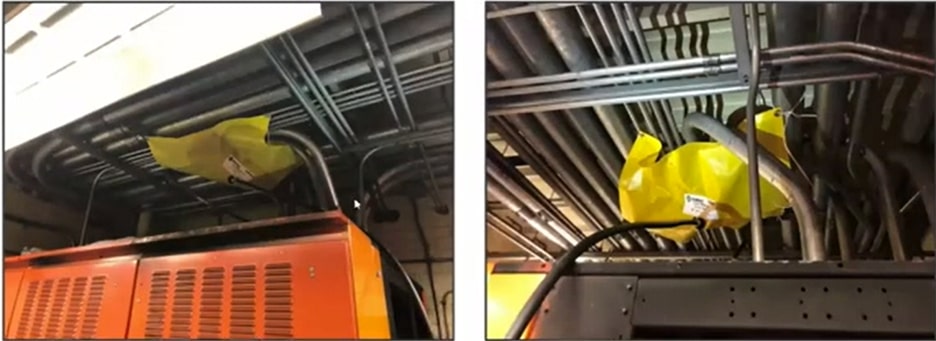
Figure 16: The ceiling area above the equipment.
Therefore, this case had outside interference towards the loss event and was reported to the property carrier. The property carrier confirmed that coverage would be afforded under their policy, just as the EBI policy did. Thus, we had a hybrid policy.
Based on the scope of repair provided by the electrical engineer, we contacted several contractors for repair estimates and made a settlement offer to the insured. In addition, based on the recommended timeline of repairs, we indicated to the insured that we would not cover the rental generator for longer than six months. Therefore, we could mitigate the extra expense exposure for the client or the insurer.
We allocated roughly 50% of the property damage and extra expense costs to the property carrier, significantly reducing our exposure.
Contact Origin and Cause for Complex Electricity Claims
We’ve explored the many aspects of Complex Claims and failure analysis throughout this article. There are a variety of reasons for electric failure, and our professional forensic team at Origin and Cause is well-versed in this area to provide an unbiased assessment of the claim. Please contact us if you require assistance with complex claims or failures that require specialized knowledge. Through a thorough scientific grasp of the issue, our team will get to the bottom of the problem.